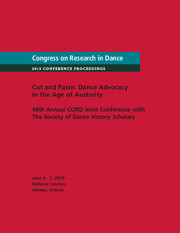No CrossRef data available.
Article contents
Red, White, and Blue: Finding the Black Behind George M. Cohan's Patriotic Success
Published online by Cambridge University Press: 05 December 2013
Abstract
George M. Cohan was one of the first dancers to juxtapose tap dancing with “all-American” tunes. After his Broadway success, Little Johnny Jones, a number of American-themed musicals, books, and films based on his life and repertoire followed. Such profound influence on American entertainment demonstrates how other social histories can slip under the cloak of one man's patriotism. Currently I am researching the relationship between tap dance and nation-ness on both the visual and aural levels. This paper illumines how tap dance choreographs individual and social histories, from the black man through the white man to the nation. Throughout its history, tap dance has frequently been subject to the problem of promoting white worth and values while at the same time denigrating black accomplishments. Cohan embodies this process of covering up black accomplishments by cloaking them in white American patriotism. On the Broadway stage, Cohan represents Irish America with buck-and-wing dancing and patriotic “rags,” but does so without blackface make-up. Cohan's removal of blackface deliberately attempts to remove any trace of blackness from material he deems valuable to the nation. By removing all hints of blackness from certain steps, and juxtaposing them with patriotic ditties, Cohan constructs a dance style that America can call its own. This paper locates where and how Cohan takes credit for steps and sounds with a complicated genealogy and connection to black America by performing them on a white proscenium stage.
- Type
- Research Article
- Information
- Copyright
- Copyright © Brynn Wein Shiovitz 2011


